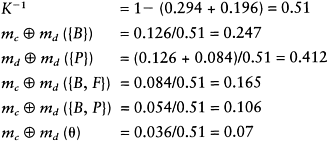211.
| [Cover] [Contents] [Index] |
Page 288
 |
|
The belief for other subsets is zero. The plausibilities for subsets {B}, {B, F}, and {B, P} are all equivalent to one, because
 |
|
The second example is an extension of the first. Suppose that there is a third observation that confirms {P} to the degree of 0.7, denoted by mc, and let ma  mb=md. The orthogonal sum mc
mb=md. The orthogonal sum mc  md is illustrated in Table 7.2. There are two null intersections, i.e. Ø. One contains the value 0.294, and the other 0.196. Therefore, the normalisation constant K and the final evidence combination results are computed by:
md is illustrated in Table 7.2. There are two null intersections, i.e. Ø. One contains the value 0.294, and the other 0.196. Therefore, the normalisation constant K and the final evidence combination results are computed by:
 |
|
and for all other subsets, mc  md=0.
md=0.
Both belief and plausibility can be derived in the similar way, as explained in example one, and so will not be duplicated here. Readers may also wish to combine bpa using the above examples, but in a different sequence. For example, one may compute the orthogonal sum first using evidence 1 and 3, and then combine to evidence 2. This exercise should show that the results of evidence combination are the same, irrespective of the ordering.
Table 7.2 Extended example of Dempster’s rule combination
| md→ mc↓ | md({B})=(0.42) | md({B, F})=(0.28) | md({B,P})=(0.18) | md(θ)=(0.12) |
| mc({P})(0.7) | Ø=0.294 | Ø=0.196 | {P}=0.126 | {P}=0.084 |
| mc(θ)(0.3) | {B}=0.126 | {B, F}=0.084 | {B, P}=0.054 | θ=0.036 |
| [Cover] [Contents] [Index] |
EAN: 2147483647
Pages: 354